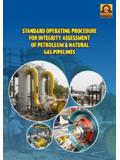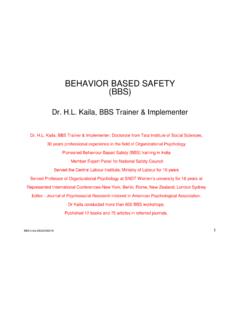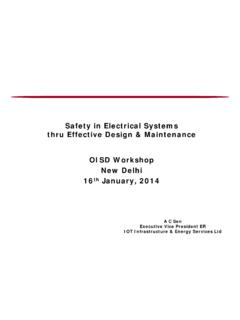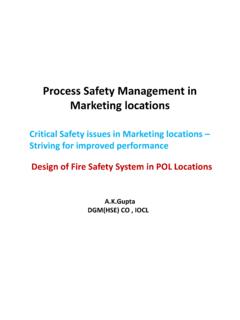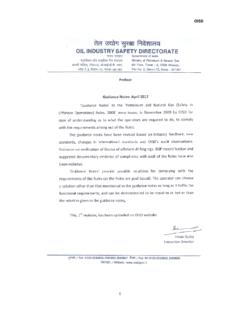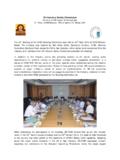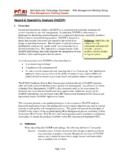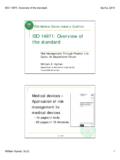Transcription of OISD
1 Quantitative Risk assessment / hazop StudyByOISDC ontents Definitions DifferenceQRA/ hazop QRAM ethodology HAZOPM ethodology QRAG oals HAZOPG oals RiskCriteria AsLowAsReasonablyPracticable(ALARP) ResidualRisk RiskMitigationMeasuresCoverage in this Presentation Fundamentals of QRA as differentiated from stand-alone Risk Analysis and hazop / HAZAN studies. assessment of residual risk after factoring in qualityof existing fire fighting system. ALARP principle of Risk Acceptance criteria. Effect of additional mitigation measures in existinglocations to reach the acceptable ALARP zoneDefinitions 4 Frequency Numberofoccurrencesperunittime.
2 Hazard chemicalorphysicalconditionwhichhasapote ntialtocausedamagetopeople,property&Envi ronment Incident Lossofmaterialorenergy. EventSequence Aspecificunplannedsequenceofeventscompri singofinitiatingevents&intermediateevent sthatmayleadtoanincident Consequence Measureofexpectedeffectsofanincidentoutc omecase. Likelihood measureofexpectedfrequencyofoccurrenceDe finitions 5 RiskAssessment processbywhichresultsofriskanalysisareus edtomakedecisionseitherthroughrelativera nkingofriskreductionstrategiesorthroughc omparisonwithrisktargets Guidewordsaresimplewordsorphasesusedtoqu alifyorquantifytheintentionandassociated parametersinordertodiscoverdeviations.
3 Parameterisanaspectoftheprocessthatdescr ibesitphysically,chemically,orintermsofw hatishappening Intentiondefineshowthesystemisexpectedto operateatthenodes Deviationsaredeparturesfromthedesigninte ntionthatarediscoveredbysystematicallyap plyingtheguidewordstoeachparameterateach nodeAnalysis of World wide accidentsDifference QRA/HAZOPQRAHAZOPQRA provides numerical(quantitative)estimates to understand risk exposure topeople and provides qualitativeestimates tounderstand risk exposure to people,Assetsand studies account for potential releasesof hazardous material, their consequences( , fire, toxic, explosion, etc.)
4 Andestimated frequency of accounts for abnormal/Hypothetical Events and their effects indownstream as well as upstreamQuantitative Riskis calculated topeople inthe form of IRPA/ SocialRiskPeople/ Assets / Environmental RiskanalysedqualitativelyRecommendations of QRA are based on themitigatingsystem to reduce theconsequence/ Likelihood and overall of RecommendationsareSafetyInstruments, Alarms,trips, OperatingProcedureto keep the system in safeoperation QRA/HAZOPQRAHAZOPRisk is calculated consideringOperatingcondition, wind speed & are analysedusing deviation inparameterline by line or by is calculated basedon number ofpeople present in the facility andsurrounding and risk areanalysedqualitatively based on risk case are not considered in case are considered in Methodology 12 Begin studySelect anodeDefine thedesign intentionSelect aparameterSpecify theintentionSelect aguidewordDevelopdeviationIdentify crediblecausesNote significantconsequencesfor each causeNote existingsafeguardsDocumentrecommendation s.
5 If anyAssign responsibility for recommendationAny other deviation? (yes)Any other guide word? (yes)Any other parameter? (yes)Any other node? (yes)Study CompleteHAZOP MethodologyQRA Goals 14 Toscreenorbrackettherangeofrisksforfurth erstudy:Itisoftenconsequenceanalysiswith outfrequencypart. ToEvaluatearangeofriskreductionmeasures: Identifymajorriskcontributors&suggestris krecommendations. Toestimateemployeerisk individualrisk Toestimatepublicrisk Societalrisk Tomeetlegalorregulatoryauthorities Toassistemergencyplanning:effectzonestob emarkedforuseinemergencyplanningHAZOP Goals Asystematicreviewofthedesign&operationof asystemtoidentifythepotentialforaccident alreleasesofhazardousmaterial,oroperabil ityproblems.
6 hazop studyiscarriedoutbyapplicationofguidewor dstoidentifyallpossibledeviationsfromdes ignintent,whichcanleadtoundesirableeffec tsonsafetyandoperability,withtheaimofide ntifyingpotentialhazards. Basedonthepremisesthat: Ahazardisnotrealizediftheprocessisalways operatedwithinitsdesignintent Creativeinputofateamisbetterthanofanindi vidual Itemcanbeapplied,independentofprocesstec hnologiesRisk Criteria 16 AsperAnnexE,IS15656:2006,HazardIdentific ationandRiskAnalysis,CodeofPractice,Risk CriteriaforQRAstudyisPlantworkerswillwor kintheIndustryon10timeshigherRiskthanSoc ialpeopleAuthority and ApplicationMaximumTolerableRisk(PerYear) Negligible Risk(Per Year)VROM, The Netherlands (New) , The Netherlands (existing) , UK (existing hazardous industry) , UK (New nuclear power station) , UK (Substance transport) , UK (New housing near plants)3 x x Kong Government (New plants) usedRisk Criteria HAZOPRiskMatrixAs low as reasonably practicable(ALARP)
7 18 low as reasonably practicable(ALARP)Residual Risk ItisnotpossibletobringdowntheRisktoZERO. Ariskthatremainsafteralleffortshavebeenm adetomitigateoreliminateriskassociatedwi thaprocess. Afterariskassessment,aresidualriskmaybek nownbutnotcompletelycontrollable,or, , Measures Asuggestedcourseofactionintendedtopreven ttheoccurrence(orrecurrence)ofanaccident eventsequence,ortomitigateitsconsequence s. RiskMitigationmeasurearehelpfultoreducet heconsequencehazardand/orreducelikelihoo dofoccurrenceand/orminimizingexposureofp eople/property. (With&WithoutESDactivation)
8 Flash Fire levelHalf LFLLFLH azard distance inmeter85 Mitigation Measures GasOilreleasefrom120m3 Storagetankwithoutprovisionofbundandsubs equentPoolfirehazardstabulatedasbelow GasOilreleasefrom120m3 Storagetankwithprovisionofbundandsubsequ entPoolfirehazardstabulatedasbelowTherma lRadiation level4 KW/m2 Hazard distance inmeter20284 NRThermal Radiationlevel4 KW/m2 Hazard distance Measures IndividualandSocietalriskcalculatedusing PHASTRISKS oftwareisasbelow ConclusionBeforemitigationRiskwasinUnacc eptableregion, RiskSocial Measures IndividualRiskContour WithoutRiskMitigationMeasuresMitigation Measures IndividualRiskContour WithRiskMitigationMeasuresMitigation Measures DemonstrationofIndividualRiskContours AfterprovidingESDandautomaticblockingsys temtoFuelgasreleasescenario, ,Consequencealsoreduced.
9 IncaseofStoragescenario,provisionofbundw illhelptoreducethehazardconsequence. Measures SomeRiskMitigationMeasuresareasbelow F&GDetectionSystemandAutomatic/SemiAutom aticBlockingSystem Containment RegularMaintenanceProcedures DelugeSystem UseofPPEs Blast-proofWalls EmergencyEvacuationplanning WaterHydrantandWatercurtain, 28 Causeof limitationImplication to CPQRAR emediesIncomplete orinadequateenumeration ofincidentsUnderestimate risk for arepresentative set orexpansive list ofincidentsRequire proper experienced alternative enumerationtechniquesPeer review/quality by facility design andoperations selectionof incidentsUnderestimate risk forall incident groupingsInvolve experienced alternative enumerationtechniquesPeer review/quality by facility design andoperations StudyLimitations 29 Cause of limitationImplication to CPQRAR emediesUnavailability
10 Ofrequired dataPossibility of systematicbiasUncertainty inconsequences,frequencies, or riskestimatesIncorrect prioritizationof major riskcontributorsSecure additional resources fordata that knowledgeable peopleare involved in assessing results against other modelsor historical incident records;evaluate 30 Cause of limitationImplication to CPQRAR emediesUnavailability ofrequired dataPossibility of systematicbiasUncertainty inconsequences,frequencies, or riskestimatesIncorrect prioritizationof major riskcontributorsSecure additional resources fordata that knowledgeable peopleare involved in assessing results against other modelsor historical incident records.
